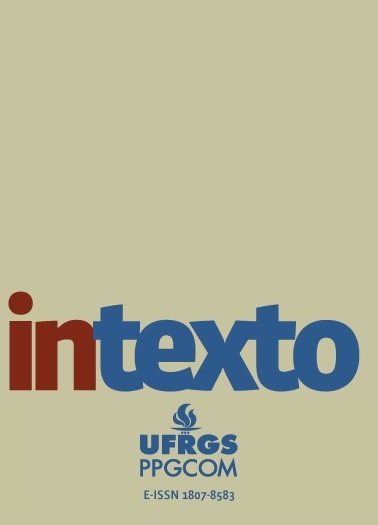Essay film
about an aesthetic of the fragment or when images think
DOI:
https://doi.org/10.19132/1807-8583.56.136459Keywords:
essay film, fragment, found footageAbstract
Our objective is to investigate how the comprehension of the essay film connected to the notion of the aesthetic of the fragment allows us to recognize the expressive powers of the images used by works in the essay domain of cinema. Furthermore, we intend to verify the discursive consequences for the essay film made with image fragments from different expression regimes. We start from the hypothesis that image fragments can act as fragments of thought, due to the character of thoughtfulness of images achieved through the encounter of different regimes of artistic expression. Therefore, we will carry out an analysis of a set of preliminary reflections on the essay film developed by us over the last few years. Finally, we signal that, through the editing exercise, the essay film is constructed by arranging these fragments of imagetic thought.
Downloads
References
ADORNO, T. W. O ensaio como forma. In: ADORNO, T. W. Notas de literatura I. São Paulo: Edição 34, 2003. p. 15-45.
ALMEIDA, R. Da montagem ao collage: found footage, voz-over e filme-ensaio. CMC: Comunicação, Mídia e Consumo, São Paulo, v. 17, n. 48, 148-168, 2020. Disponível em:
https://doi.org/10.18568/cmc.v17i48.1912. Acesso em: 5 mar. 2024.
ALMEIDA, R. Do espectador pensativo à imagem pensativa: fotografia e filme-ensaio. Revista FAMECOS, Porto Alegre, v. 24, n. 2, p. 1-14, 2017a. Disponível em: https://doi.org/10.15448/1980-3729.2017.2.25025. Acesso em: 5 mar. 2024.
ALMEIDA, R. Entre a chegada e a partida: reciclagens do cinema doméstico no filme-ensaio. Matrizes, São Paulo, v. 11, n. 2, p. 271-286, 2017b. Disponível em: http://dx.doi.org/10.11606/issn.1982-8160.v11i2p271-286. Acesso em: 5 mar. 2024.
ARTHUR, P. En busca de los archivos perdidos. Archivos de la Filmoteca, Valencia, feb. 2008.
ARTHUR, P. Essay questions: from Alain Resnais to Michael Moore. Film Comment, New York, v. 39, n. 1, p. 58-62, Jan. 2003.
AUMONT, J. A estética do filme. Campinas: Papirus, 1995.
BENJAMIN, W. Origem do drama barroco alemão. São Paulo: Brasiliense, 1984.
BERNARDET, J.-C. O espectador como montador. Folha de S. Paulo, São Paulo, 15 ago. 1999.
BLÜMLINGER, C. Leer entre las imágenes. In: WEINRICHTER, A. (org.). La forma que piensa: tentativas en torno al cine-ensayo. Pamplona: Gobierno de Navarra, 2007.
CATALÀ DOMÈNECH, J. Film-ensayo y vanguardia. In: TORREIRO, C.; CERDÁN, J. (org.). Documental y vanguardia. Madrid: Cátedra, 2005. p. 109-158.
CATALÀ DOMÈNECH, J. News of the end of the world: the essay film as mentality. Comparative Cinema, Barcelona, v. 10, n. 18, p. 117-138, 2022. Disponível em: https://doi.org/10.31009/cc.2022.v10.i18.02. Acesso em: 5 mar.2024.
COMOLLI, J-L. Ver e poder: a inocência perdida - cinema, televisão, ficção, documentário. Belo Horizonte: Ed. da UFMG, 2008.
CORRIGAN, T. O filme-ensaio: desde Montaigne e depois de Marker. Campinas: Papirus, 2015.
LINS, C. Do espectador crítico ao espectador-montador: um dia na vida, de Eduardo Coutinho. Devires: Cinema e Humanidades, Belo Horizonte v. 7, n. 2, p. 132-138, 2010.
RANCIÈRE, J. O espectador emancipado. São Paulo: WMF Martins Fontes, 2012.
RASCAROLI, L. The personal camera: subjective cinema and the essay film. New York: Wallflower Press, 2009.
VAQUERO, L. G.; LÓPEZ, S. G. Introducción. In: VAQUERO, L. G.; LÓPEZ, S. G. (org.). Piedra, papel y tijera: el collage en el cine documental. Madrid: Ocho y medio libros de cine, 2009.
WEES, W. C. Recycled images: the art and politics of found footage film. New York: Anthology Film Archives, 1993.
WEINRICHTER, A. Notas sobre collage y cine. In: VAQUERO, L. G.; LÓPEZ, S. G. (org.). Piedra, papel y tijera: el collage en el cine documental. Madrid: Ocho y medio libros de cine, 2009.
WEINRICHTER, A. Un concepto fugitivo: notas sobre el film-ensayo. In: WEINRICHTER, A. (org.). La forma que piensa: tentativas en torno al cine-ensayo. Pamplona: Gobierno de Navarra, 2007. p. 18-48.
ZRYD, M. Found footage film as discursive metahistory: Craig Baldwin's tribulation 99. The Moving Image, Minnesota, v. 3, n. 2, p. 40-61, 2003. Disponível em: 10.1353/mov.2003.0039. Acesso em: 5 mar. 2024.
Downloads
Published
How to Cite
Issue
Section
License
Copyright (c) 2024 Rafael de Almeida

This work is licensed under a Creative Commons Attribution-NonCommercial 4.0 International License.
The copyright of works published in this journal belong to the authors, and the right of first publication is conceded to the journal. Due to the journal being of open access, the articles are of free use in research, educational and non-commercial activities.
Therefore, the journal uses the License Creative Commons Attribution (CC BY-NC 4.0), which allows sharing of work with acknowledgment of authorship.
Self-archiving (repository policy): authors are allowed to deposit all versions of their work in institutional or thematic repositories without embargo. It is requested, whenever possible, that the full bibliographic reference of the version published in Intexto (including the DOI link) be added to the archived text.
Intexto does not charge any article processing fees (article processing charge).















